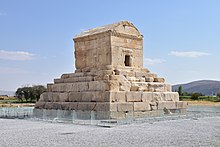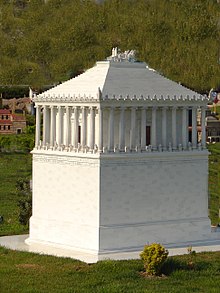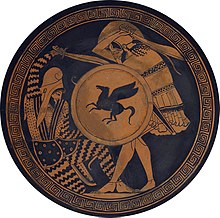Achaemenid Empire
[20] The name "Persia" is a Greek and Latin pronunciation of the native word referring to the country of the people originating from Persis (Old Persian: 𐎱𐎠𐎼𐎿, romanized: Pārsa).[63][64] Herodotus depicts Cambyses as openly antagonistic to the Egyptian people and their gods, cults, temples, and priests, in particular stressing the murder of the sacred bull Apis.This allowed two Magi to rise up against Cambyses, with one of them sitting on the throne able to impersonate Bardiya because of their remarkable physical resemblance and shared name (Smerdis in Herodotus's accounts[d]).[75] Ctesias writes that when Cambyses had Bardiya killed he immediately put the magus Sphendadates in his place as satrap of Bactria due to a remarkable physical resemblance.[58] Whatever the exact circumstances of the revolt, Cambyses heard news of it in the summer of 522 BC and began to return from Egypt, but he was wounded in the thigh in Syria and died of gangrene, so Bardiya's impersonator became king.[80] Iranologist Pierre Briant hypothesises that Bardiya was not killed by Cambyses, but waited until his death in the summer of 522 BC to claim his legitimate right to the throne as he was then the only male descendant of the royal family.[81] According to the Behistun inscription, Gaumata ruled for seven months before being overthrown in 522 BC by Darius the Great (Old Persian Dāryavuš, "who holds firm the good", also known as Darayarahush).The subjugation of Macedonia was part of Persian military operations initiated by Darius the Great (521–486) in 513—after immense preparations—a huge Achaemenid army invaded the Balkans and tried to defeat the European Scythians roaming to the north of the Danube river.[citation needed] The Persians continued to reduce the cities along the west coast that still held out against them, before finally imposing a peace settlement in 493 BC on Ionia that was generally considered to be both just and fair.His army entered Greece from the north in the spring of 480 BC, meeting little or no resistance through Macedonia and Thessaly, but was delayed by a small Greek force for three days at Thermopylae.[99] Following his victory at the Battle of Thermopylae, Xerxes sacked the evacuated city of Athens and prepared to meet the Greeks at the strategic Isthmus of Corinth and the Saronic Gulf.After a year of fighting the Egyptian Pharaoh, Nectanebo inflicted a crushing defeat on the Persians with the support of mercenaries led by the Greek generals Diophantus and Lamius.Both satraps suffered crushing defeats at the hands of Tennes, the Sidonese king, who was aided by 40,000 Greek mercenaries sent to him by Nectanebo II and commanded by Mentor of Rhodes.[citation needed] The character of the country, intersected by numerous canals and full of strongly fortified towns, was in his favour and Nectanebo II might have been expected to offer a prolonged, if not even a successful resistance.As a result, the Persians were able to rapidly reduce numerous towns across Lower Egypt and were advancing upon Memphis when Nectanebo decided to quit the country and flee southwards to Ethiopia.The kingdom grew to its largest extent under Mithridates VI the Great, who conquered Colchis, Cappadocia, Bithynia, the Greek colonies of the Tauric Chersonesos and for a brief time the Roman province of Asia.India was clearly already fabled for its gold; Egypt was known for the wealth of its crops; it was to be the granary of the Persian Empire (as later of Rome's) and was required to provide 120,000 measures of grain in addition to 700 talents of silver.[citation needed] Another highway of commerce was the Great Khorasan Road, an informal mercantile route that originated in the fertile lowlands of Mesopotamia and snaked through the Zagros highlands, through the Iranian plateau and Afghanistan into the Central Asian regions of Samarkand, Merv and Ferghana, allowing for the construction of frontier cities like Cyropolis.Following Alexander's conquests, this highway allowed for the spread of cultural syncretic fusions like Greco-Buddhism into Central Asia and China, as well as empires like the Kushan, Indo-Greek and Parthian to profit from trade between East and West.[160] Due to the ethno-cultural diversity of the subject nations under the rule of Persia, its enormous geographic size, and the constant struggle for power by regional competitors,[20] the creation of a professional army was necessary for both maintenance of the peace and to enforce the authority of the king in cases of rebellion and foreign threat.[21][143] Cyrus managed to create a strong land army, using it to advance in his campaigns in Babylonia, Lydia, and Asia Minor, which after his death was used by his son Cambyses II, in Egypt against Psamtik III.[citation needed] The empire's great armies were, like the empire itself, very diverse, having:[f] Persians,[163] Macedonians,[84] European Thracians, Paeonians, Medes, Achaean Greeks, Cissians, Hyrcanians,[164] Assyrians, Chaldeans,[165] Bactrians, Sacae,[166] Arians, Parthians, Caucasian Albanians,[167] Chorasmians, Sogdians, Gandarans, Dadicae,[168] Caspians, Sarangae, Pactyes,[169] Utians, Mycians, Phoenicians, Judeans, Egyptians,[170] Cyprians,[171] Cilicians, Pamphylians, Lycians, Dorians of Asia, Carians, Ionians, Aegean islanders, Aeolians, Greeks from Pontus, Paricanians,[172] Arabians, Ethiopians of Africa,[173] Ethiopians of Baluchistan,[174] Libyans,[175] Paphlagonians, Ligyes, Matieni, Mariandyni, Cappadocians,[176] Phrygians, Armenians,[177] Lydians, Mysians,[178] Asian Thracians,[179] Lasonii, Milyae,[180] Moschi, Tibareni, Macrones, Mossynoeci,[181] Mares, Colchians, Alarodians, Saspirians,[182] Red Sea islanders,[183] Sagartians,[184] Hindush,[185] Eordi, Bottiaei, Chalcidians, Brygians, Pierians, Perrhaebi, Enienes, Dolopes, and Magnesians.[186] Surviving Achaemenid colored glazed bricks and carved reliefs represent the Immortals as wearing elaborate robes, hoop earrings and gold jewellery, though these garments and accessories were most likely worn only for ceremonial occasions.The Sparabara were taken from the full members of Persian society, were trained from childhood to be soldiers and when not called out to fight on campaigns in distant lands they practised hunting on the vast plains of Persia.This, however, left them at a severe disadvantage against heavily armoured opponents such as the hoplite, and their two-metre-long spear was not able to give the Sparabara ample range to plausibly engage a trained phalanx.[195] Despite this achievement, the personnel for the imperial navy would not come from Iran, but were often Phoenicians (mostly from Sidon), Egyptians and Greeks chosen by Darius the Great to operate the empire's combat vessels.He also observed that the Persians drank wine in large quantities and used it even for counsel, deliberating on important affairs when drunk, and deciding the next day, when sober, whether to act on the decision or set it aside.[220][221] During the reign of Artaxerxes I and Darius II, the Greek historian Herodotus wrote: "[the Persians] have no images of the gods, no temples nor altars, and consider the use of them a sign of folly."[222] The Babylonian scholar and priest Berosus records—although writing over seventy years after the reign of Artaxerxes II—that the emperor had been the first to make cult statues of divinities and have them placed in temples in many of the major cities of the empire.[242]Will Durant, the American historian and philosopher, during one of his speeches, "Persia in the History of Civilization", as an address before the Iran–America Society in Tehran on 21 April 1948, stated: For thousands of years Persians have been creating beauty.












































Persian Empire (disambiguation)Standard of Cyrus the GreatDarius the GreatBabylonPasargadaeEcbatanaPersepolisOld PersianAramaicAkkadianElamiteMedianZoroastrianismMesopotamian religionJudaismVedic HinduismEgyptian religionGreek religionGovernmentMonarchyCyrus the GreatCambyses IIBardiyaGaumataXerxes IArtaxerxes IXerxes IISogdianusDarius IIArtaxerxes IIArtaxerxes IIIDarius IIIClassical antiquityPersian RevoltConquest of LydiaConquest of BabylonConquest of Indus ValleyConquest of EgyptEuropean Scythian CampaignGreco-Persian WarsBabylonian RevoltsCorinthian WarGreat Satraps' RevoltFall to MacedoniasiglosPersisMedian kingdomNeo-Babylonian EmpireSindhu-SauvīraGandhāra (kingdom)PauravasTwenty-sixth Dynasty of EgyptMacedonia (ancient kingdom)Macedonian EmpireGandharaAśvakaOfficial languagelingua francaBabyloniaIranianAchaemenid dynastyBalkansWest AsiaCentral AsiaIndus ValleyIranian plateauPersiansMedian Empireroad systemsorganized postal systema large, professional armyAlexander the GreatAlexander's deathHellenistic periodPtolemaic KingdomSeleucid EmpirePartition of TriparadisusParthian EmpireAchaemenesbahuvrihiAnshanAssyriaPersianTeispidsAchaemenid family treeMaraphiiMaspiiDropiciSagartinomadicHerodotusHistoriesIranian peopleZagros MountainsElamitesnomadic pastoralistsMarvdashtCyrus CylinderTeispesCyrus ICambyses ICyrus IIBehistun InscriptionMandane of MediaAstyagesWars of Cyrus the GreatFirst Achaemenid conquest of EgyptAchaemenid invasion of the Indus ValleyEuropean Scythian campaign of Darius ICroesusSardisPactyesMazaresHarpagusBactriagarrison townsCyropolisFall of BabylonSipparNabonidusMardukNeo-Assyrian EmpireAshurbanipalJerusalemSecond TempleCyrus the Great's tomb
